Order-4 octagonal tiling
| Order-4 octagonal tiling | |
|---|---|
 Poincaré disk model of the hyperbolic plane | |
| Type | Hyperbolic regular tiling |
| Vertex configuration | 84 |
| Schläfli symbol | {8,4} r{8,8} |
| Wythoff symbol | 4 | 8 2 |
| Coxeter diagram | |
| Symmetry group | [8,4], (*842) [8,8], (*882) |
| Dual | Order-8 square tiling |
| Properties | Vertex-transitive, edge-transitive, face-transitive |
In geometry, the order-4 octagonal tiling is a regular tiling of the hyperbolic plane. It has Schläfli symbol of {8,4}. Its checkerboard coloring can be called a octaoctagonal tiling, and Schläfli symbol of r{8,8}.
Uniform constructions
There are four uniform constructions of this tiling, three of them as constructed by mirror removal from the [8,8] kaleidoscope. Removing the mirror between the order 2 and 4 points, [8,8,1+], gives [(8,8,4)], (*884) symmetry. Removing two mirrors as [8,4*], leaves remaining mirrors *4444 symmetry.
| Uniform Coloring |
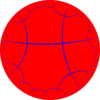
|
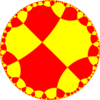
|
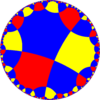
|
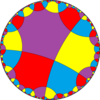
|
|---|---|---|---|---|
| Symmetry | [8,4] (*842) |
[8,8] (*882) |
[(8,4,8)] = [8,8,1+] (*884)
|
[1+,8,8,1+] (*4444) |
| Symbol | {8,4} | r{8,8} | r(8,4,8) = r{8,8}1⁄2 | r{8,4}1⁄8 = r{8,8}1⁄4 |
| Coxeter diagram |
|
Symmetry
This tiling represents a hyperbolic kaleidoscope of 8 mirrors meeting as edges of a regular hexagon. This symmetry by orbifold notation is called (*22222222) or (*28) with 8 order-2 mirror intersections. In Coxeter notation can be represented as [8*,4], removing two of three mirrors (passing through the octagon center) in the [8,4] symmetry. Adding a bisecting mirror through 2 vertices of an octagonal fundamental domain defines a trapezohedral *4422 symmetry. Adding 4 bisecting mirrors through the vertices defines *444 symmetry. Adding 4 bisecting mirrors through the edge defines *4222 symmetry. Adding all 8 bisectors leads to full *842 symmetry.
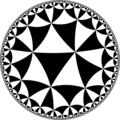 *444 |
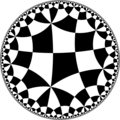 *4222 |
 *832 |
The kaleidoscopic domains can be seen as bicolored octagonal tiling, representing mirror images of the fundamental domain. This coloring represents the uniform tiling r{8,8}, a quasiregular tiling and it can be called a octaoctagonal tiling.

|
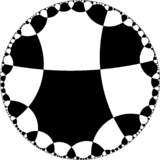
|
Related polyhedra and tiling
This tiling is topologically related as a part of sequence of regular tilings with octagonal faces, starting with the octagonal tiling, with Schläfli symbol {8,n}, and Coxeter diagram ![]()
![]()
![]()
![]()
![]() , progressing to infinity.
, progressing to infinity.
| *n42 symmetry mutation of regular tilings: {n,4} | |||||||
|---|---|---|---|---|---|---|---|
| Spherical | Euclidean | Hyperbolic tilings | |||||

|

|

|

|

|

|

|

|
| 24 | 34 | 44 | 54 | 64 | 74 | 84 | ...∞4 |
| Regular tilings: {n,8} | |||||||||||
|---|---|---|---|---|---|---|---|---|---|---|---|
| Spherical | Hyperbolic tilings | ||||||||||
 {2,8} |
 {3,8} |
 {4,8} |
 {5,8} |
 {6,8} |
 {7,8} |
 {8,8} |
... |  {∞,8} | |||
This tiling is also topologically related as a part of sequence of regular polyhedra and tilings with four faces per vertex, starting with the octahedron, with Schläfli symbol {n,4}, and Coxeter diagram ![]()
![]()
![]()
![]()
![]() , with n progressing to infinity.
, with n progressing to infinity.
 {3,4} |
 {4,4} |
 {5,4} |
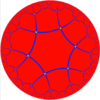 {6,4} |
 {7,4} |
 {8,4} |
... |  {∞,4} |
| Uniform octagonal/square tilings | |||||||||||
|---|---|---|---|---|---|---|---|---|---|---|---|
| [8,4], (*842) (with [8,8] (*882), [(4,4,4)] (*444) , [∞,4,∞] (*4222) index 2 subsymmetries) (And [(∞,4,∞,4)] (*4242) index 4 subsymmetry) | |||||||||||
= = = |
= |
= = = |
= |
= = |
= |
||||||

|

|

|

|

|

|

| |||||
| {8,4} | t{8,4} |
r{8,4} | 2t{8,4}=t{4,8} | 2r{8,4}={4,8} | rr{8,4} | tr{8,4} | |||||
| Uniform duals | |||||||||||

|

|

|

|

|

|

| |||||
| V84 | V4.16.16 | V(4.8)2 | V8.8.8 | V48 | V4.4.4.8 | V4.8.16 | |||||
| Alternations | |||||||||||
| [1+,8,4] (*444) |
[8+,4] (8*2) |
[8,1+,4] (*4222) |
[8,4+] (4*4) |
[8,4,1+] (*882) |
[(8,4,2+)] (2*42) |
[8,4]+ (842) | |||||
= |
= |
= |
= |
= |
= |
||||||

|

|

|

|

|

|

| |||||
| h{8,4} | s{8,4} | hr{8,4} | s{4,8} | h{4,8} | hrr{8,4} | sr{8,4} | |||||
| Alternation duals | |||||||||||

|

|

|

|

|
|||||||
| V(4.4)4 | V3.(3.8)2 | V(4.4.4)2 | V(3.4)3 | V88 | V4.44 | V3.3.4.3.8 | |||||
| Uniform octaoctagonal tilings | |||||||||||
|---|---|---|---|---|---|---|---|---|---|---|---|
| Symmetry: [8,8], (*882) | |||||||||||
= |
= |
= |
= |
= |
= |
= | |||||

|

|

|

|

|

|

| |||||
| {8,8} | t{8,8} |
r{8,8} | 2t{8,8}=t{8,8} | 2r{8,8}={8,8} | rr{8,8} | tr{8,8} | |||||
| Uniform duals | |||||||||||

|

|

|

|

|

|

| |||||
| V88 | V8.16.16 | V8.8.8.8 | V8.16.16 | V88 | V4.8.4.8 | V4.16.16 | |||||
| Alternations | |||||||||||
| [1+,8,8] (*884) |
[8+,8] (8*4) |
[8,1+,8] (*4242) |
[8,8+] (8*4) |
[8,8,1+] (*884) |
[(8,8,2+)] (2*44) |
[8,8]+ (882) | |||||
= |
= | ||||||||||

|

|

|

|

| |||||||
| h{8,8} | s{8,8} | hr{8,8} | s{8,8} | h{8,8} | hrr{8,8} | sr{8,8} | |||||
| Alternation duals | |||||||||||

|

|
||||||||||
| V(4.8)8 | V3.4.3.8.3.8 | V(4.4)4 | V3.4.3.8.3.8 | V(4.8)8 | V46 | V3.3.8.3.8 | |||||
See also
References
- John H. Conway, Heidi Burgiel, Chaim Goodman-Strauss, The Symmetries of Things 2008, ISBN 978-1-56881-220-5 (Chapter 19, The Hyperbolic Archimedean Tessellations)
- "Chapter 10: Regular honeycombs in hyperbolic space". The Beauty of Geometry: Twelve Essays. Dover Publications. 1999. ISBN 0-486-40919-8. LCCN 99035678.

